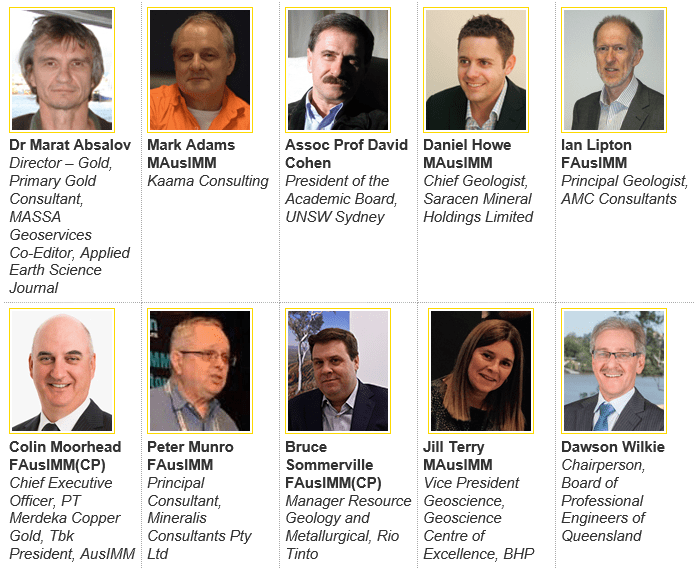The 2017 September quarter Australian geoscientist employment survey is open for contributions until 21st October. You can complete the survey here.
This survey will provide data on trends in geoscientist employment in Australia during the third (June to September) quarter of 2017.
The June 2017 employment survey showed that unemployment and under-employment for geoscientists continued to improve, although the rate of improvement was observed to differ markedly between different sectors of our profession. Mineral exploration fared worse than metalliferous mining and energy resource exploration and production. The survey results supported a broader perception of improving employment conditions for mining professionals but demonstrated that Australia’s mineral project pipeline remains fragile due to a lack of exploration contributing to new discoveries needed to sustain the industry. Exploration investment, however, has also increased according to Australian Bureau of Statistics figures. This survey will provide data on whether this has contributed to improved employment opportunities.
AIG needs your support by completing this survey. The survey results are reported widely and used to promote and inform others of the health of our exploration and mining industry. The data supports advocacy by AIG on the need for responsible, sustainable resource exploration throughout Australia.
The survey takes only two minutes to complete. You do not need to be an AIG member to contribute. No data that could personally identify respondents is collected.
Your completing the survey really helps to make a difference to the standing and knowledge of our profession.
The survey will remain open for contributions until 21st October but please take two minute to complete it now.
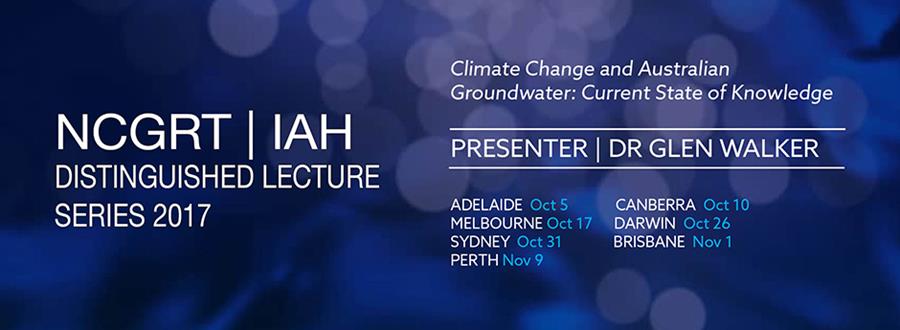
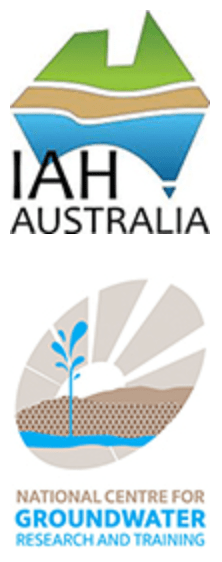 Last chance to register for the 2017 NCGRT IAH Distinguished Lecture presented by Dr Glen Walker
Last chance to register for the 2017 NCGRT IAH Distinguished Lecture presented by Dr Glen Walker
The climate shift in south-western Western Australia and the Millennium Drought has highlighted the need to better understand how water resources will be affected by changing climate across Australia. Australia has long experience with managing water resources in a variable climate. This, together with the Water Reform has meant that Australia is well placed, compared to other countries, to meet the challenges to groundwater management.
This talk will provide an overview of the results from recent projects around Australia and will be supported by local panellists in each state contributing to the discussion.
Click here for full abstract and Dr Walker’s bio. Click here for the national tour flyer.
A video link will be provided to Hobart and Townsville delegates.
Click here for venue and registration information
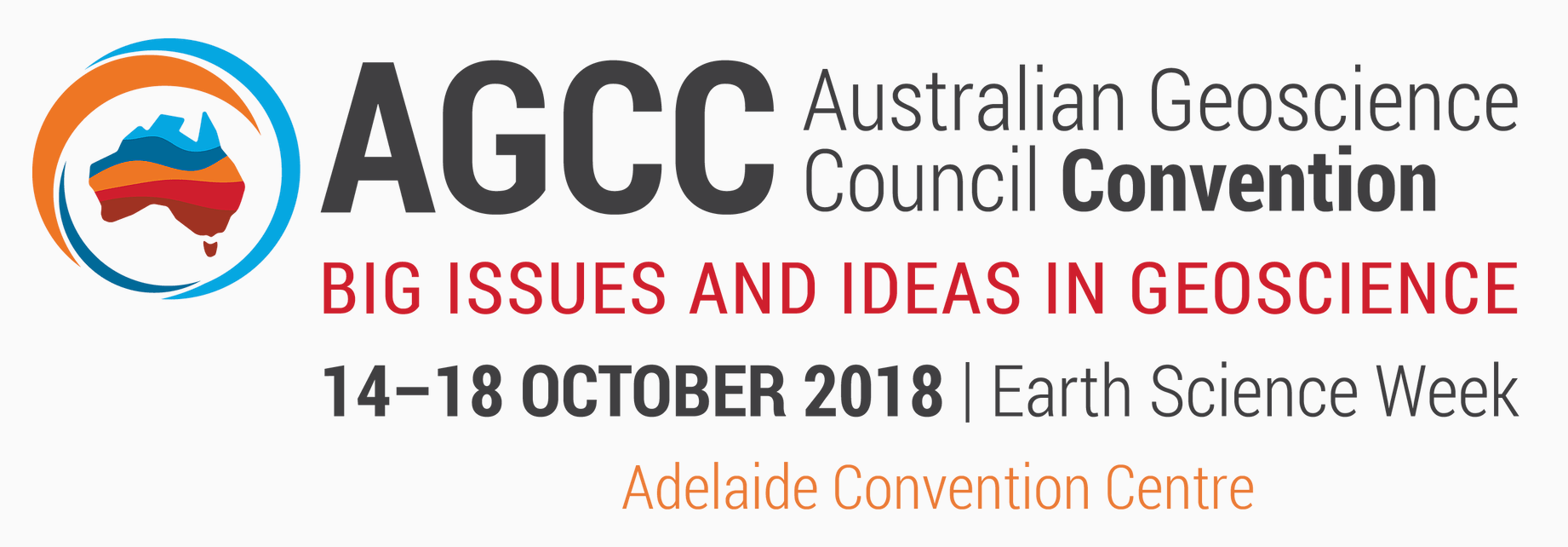
The Australian Geoscience Council Convention (AGCC2018) will highlight the fundamental role that Geoscience has as a major field of science throughout the Asia Pacific Region. The Convention (AGCC 2018) will be the largest Geoscience event to be held in Australasia since 2012, with delegates from all branches of Geoscience plus experts in mining, energy, engineering, environment and other disciplines interested in resource development expected to attend.
AGCC 2018 is supported by all eight Member Organisations of the Australian Geoscience Council, and is proudly sponsored by Geoscience Australia.
Please follow this link to the FIRST CIRCULAR for the Australian Geoscience Council Convention 2018.
The Australian Geoscience Council is pleased to announce the draft program for AGCC 2018.
The Convention’s program will cover all aspects of geoscience, with technical themes on theoretical and applied Geoscience, mineral and energy resources, environmental and societal science, Geoscience education and communication, and emerging technologies.
Details of the program, how to register your interest in chairing a session and more can be found in the AGCC 2018 First Circular.
Pre-and post- Convention field trips to classic locations in South Australia and a variety of day tours to places of geological, scenic and cultural interest will complement the Convention.
Please read the AGCC 2018 First Circular for more information on field trips and how to register your interest in running a field trip or a workshop.
AGCC 2018 is pleased to announce Geoscience Australia as Patron Sponsor.
The AGCC 2018 exhibition space will offer the opportunity to showcase your brand, services and products to industry leaders, major Government and corporate decision makers, as well as expand your network with the industry leaders of Australia and the Asia Pacific region.
A range of sponsorship options are available to suit varying needs and budgets. For a copy of the Partnership Opportunities document, please contact our Industry and Event specialist Jess Tuffley,
• Join our mailing list
• AGCC 2018 website
• AGCC 2018 First Circular

The Australian Geoscience Council Convention, AGCC 2018, is excited to announce Geoscience Australia as the Patron Sponsor of the event, which will be held in Adelaide from Sunday 14th to Thursday 18th of October next year.
The Convention, which is expected to attract more than 2,000 delegates from Australia and overseas, will cover all aspects of Geoscience, with technical themes on theoretical and applied Geoscience, mineral and energy resources, environmental and societal science, Geoscience education and communication, and emerging technologies.
Geoscience Australia Chief Executive Officer Dr James Johnson said sponsoring the Convention was a great opportunity to showcase the importance of Geoscience and the work of the organisation in the lives of all Australians, from maps that support decision making and GPS positioning on your mobile phone, to environmental monitoring and understanding the nation’s resource wealth.
“The Convention is a great opportunity for us to come together with representatives from around the world and across the field of Geoscience to discuss not only scientific developments and emerging technologies, but also new approaches to education and communication” he said.
Geoscience Australia is Australia’s pre-eminent public-sector Geoscience organisation. They are Australia’s trusted advisor on the geology and geography of the country. Geoscience Australia applies science and technology to describe and understand the Earth for the benefit of Australia.
AGCC 2018 will be the largest Geoscience event to be held in the Asia Pacific Region since 2012. It will feature a wide ranging scientific program, a range of pre- and post- Convention field trips, a large exhibition, expert training workshops and an education program.
Under the theme Big Issues and Ideas in Geoscience, AGCC 2018 will examine and address current and emerging issues that affect geoscientists and our society, with particular focus on energy security, resource development in Northern Australia, Geoscience education and communication, and the impact of boom-and-bust commodity cycles.
The Convention, which will attract some of Australia’s and the world’s leading geoscientists, will occupy the entire East Building of the Adelaide Convention Centre (ACC).
For more information and to explore exhibition and partnership opportunities, please visit www.agcc.org.au.

Any geoscientist working in mineral exploration in Australia over the past few years will tell you that the sector has been doing it tough. Junior explorers have experienced di culties raising capital. There appears to have not been a lot of mid-tier to major company interest in exploration in recent years, with a few notable exceptions. The industry as a whole has faced a growing burden associated with gaining access to land in the form of long lead times between applying for exploration licences and having them granted, and a mountain of red tape associated with permitting for even very low- impact exploration activities. The latest Australian Geoscientist Employment Survey showed that the unemployment rate for geoscientists in exploration is two to three-times that of geoscientists working in other sectors of our profession.
Governments, state and federal, have tried numerous approaches, mostly centred around nancial support of exploration drilling or limited tax incentives to attempt to promote exploration investment. A further,
tax incentive based scheme was presented by Prime Minister Malcolm Turnbull in a speech to the Liberal Party Western Australia state conference only last weekend. To date, though, there’s not a lot of evidence to suggest that these schemes are having any real or lasting impact. The proportion of each Australian state held under some form of exploration title has fallen steadily since 2011 according to information compiled by Doug Brewster, a Brisbane based AIG member.
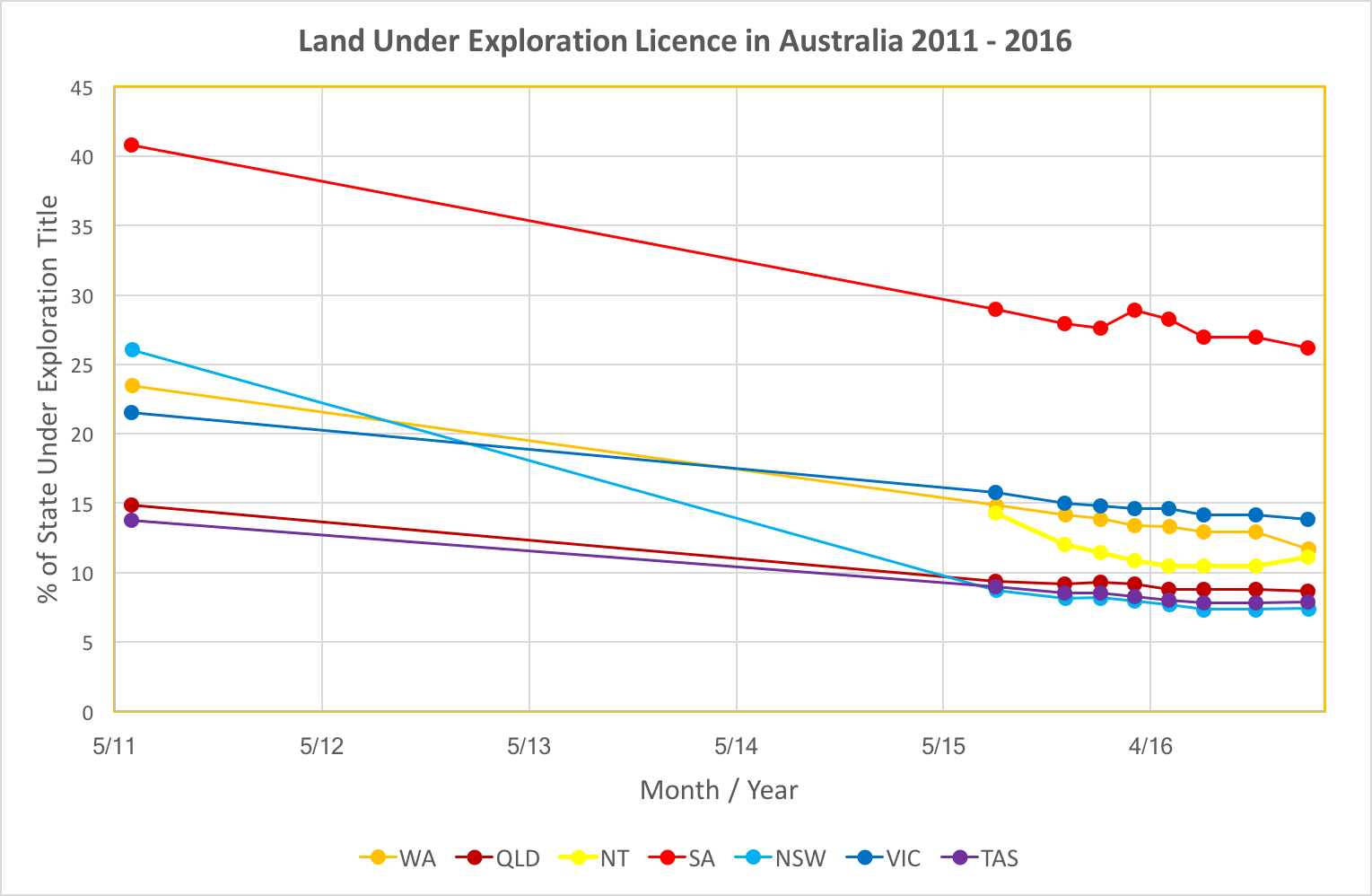
Some Australian states are perceived to be poor destinations for exploration investment according to the Fraser Institute’s annual Survey of Mining Companies in 2016, in which only Western Australia was ranked in the top 10 exploration investment destinations globally.
A survey has been established to harness the ideas and experience of geoscientists working in the exploration sector. Please take time to complete the survey and contribute your views and opinions. The survey will remain open until 27th October.
You can also participate in the conversation via the AIG website, by posting comments here, and via the AIG Linkedin Group.
Inclusion and Diversity is a concept receiving considerable attention in modern workplaces. Australian exploration and mining sector workplaces are no exception. A growing number of companies are coming to consider the promotion of inclusion and diversity in workplaces essential to business success and take proactive steps to promote underlying principles and values. Views of what inclusion and diversity means in the context of Australian geoscience is subject to varying interpretations and views, although it’s probably fair to say that this is true for many other professions also.
The concept of inclusion and diversity means different things to different groups. Diversity encompasses issues of gender, ethnicity, generation, sexual orientation, national status, disabilities, employment tenure and level within an organization. Essentially, diversity facilitates blending of different backgrounds, experiences, and perspectives within a team. Inclusion is perhaps best defined as support for a collaborative environment that values open participation from individuals with different ideas and perspectives that has a positive impact on business. Management in an inclusive organisation is transparent, communicative and engaging. Organizations are considered to need to embrace inclusion and diversity principles to foster innovation that, in turn, promotes best use of the organizations talent, drives productivity, delivers continuous improvement and creates value in a real sense.
These concepts have been gaining prominence over the past decade and more. The International Association for Geoscience Diversity (IAGD) was formed in 2008 specifically to improve access to the geosciences for individuals with disabilities and promote communities of inclusive research, instruction and student support (http://www.theiagd.org), a reflection of the growing interest in the value and awareness of the need for greater inclusion and diversity in our profession. IAGD’s stated objectives are squarely focussed on enhancing opportunities for geoscientists with disabilities, but the association’s work and interests appear to be gradually becoming more widely focussed.
The 2016 Census revealed that more than 50% of Australians were, themselves, or have at least one parent born overseas, which clearly puts the issue of ethnic diversity in the spotlight. The most simplistic view of gender diversity is that workplaces should provide employment opportunities that are not constrained by gender. This is not, however, synonymous with saying that equal proportions of professional roles should be filled by men and women. Qualifications, skills and experience have an influence on the population available to different professions. Gender diversity within professions is an important consideration and is, currently, very dynamic. Attitudes to diversity need to keep pace with continuously changing circumstances.
AIG’s membership database and employment survey data provide very useful insights into diversity, particularly in Australian exploration and mining, but also in other sectors of our profession.
Overall, men comprise 86% of AIG’s Fellows, Members, Graduates, Students and Retired members, women 14% (Figure 1). This split, however, varies considerably by generation. Women comprise 12% of AIG Members and Fellows (by definition members with at least 15 years of professional experience for Fellows, and more than 5 years professional experience in the case of Members), but comprise 29% of Graduate members (less than five years experience since graduation) and 34% of Student members (the future of our profession) (Figure 2).
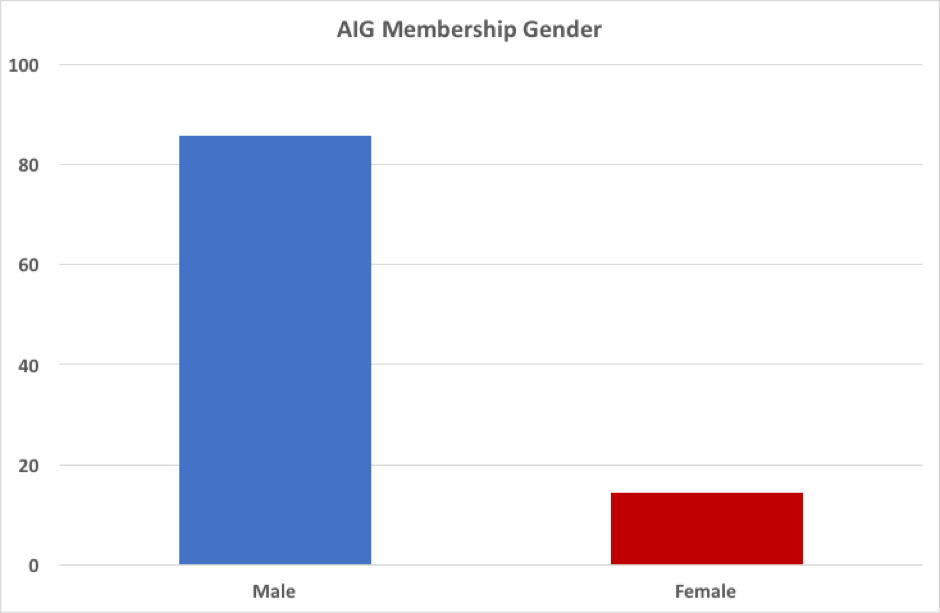
Figure 1. AIG Membership by Gender (Fellow, Member, Graduate, Student and Retired members). A very small number of members also elect to be identified as neither men nor women.
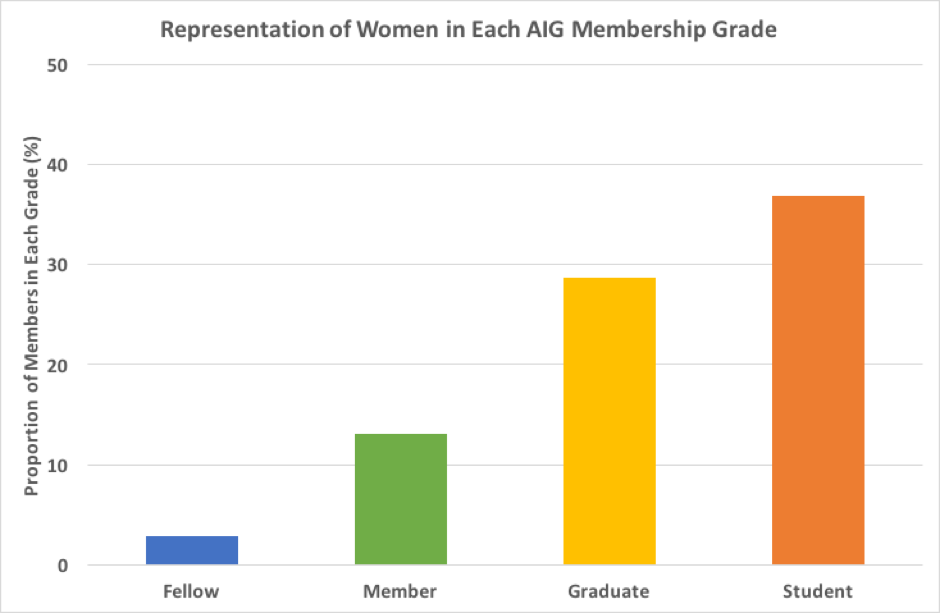
Figure 2. Representation of Women in each AIG membership grade.
Clearly, geoscience is becoming progressively more diverse, with an increasing proportion of women in the ranks of early professionals.
It’s useful to examine some other diversity and inclusion metrics to assess how Australian geoscience is developing.
There are essentially no differences evident between the breakdown of geoscience qualifications attained by men and women. Around 16% of members hold Bachelor degrees as their highest qualification and around 35% hold Honours degrees. Some six to seven percent have gone on to attain a Graduate Diploma, 26% a Masters degree and about 15% a PhD as their highest qualification (Figure 3). There are clearly barriers to inclusion and diversity on the basis of education.
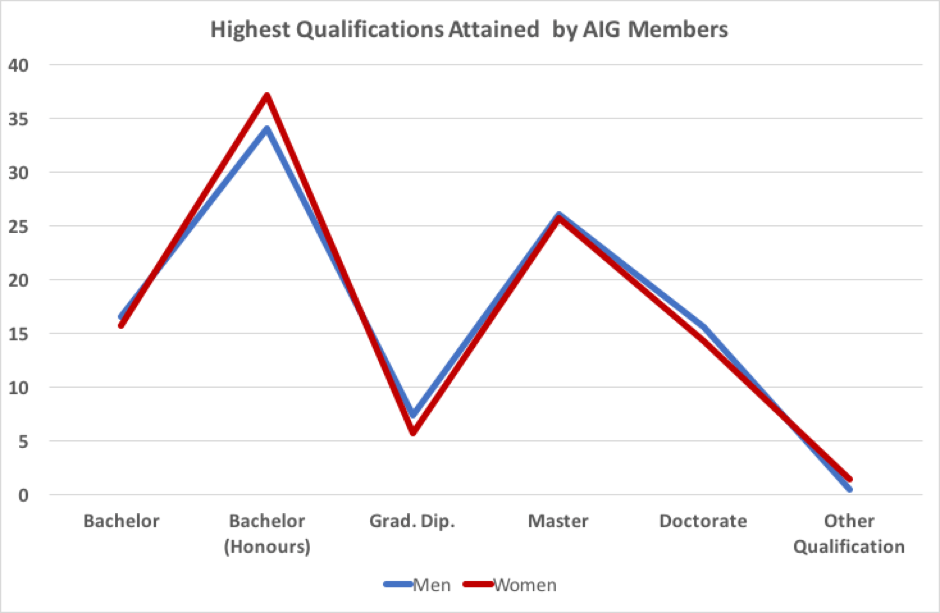
Figure 3. Highest academic qualifications attained by AIG members
The unemployment rate amongst women geoscientists in the June 2017 AIG Australian Geoscientist Employment Survey was 7.9%, significantly lower than the overall unemployment rate recorded by the survey of 11.3%.
Looking at professional experience, in simple numerical terms there are more men than women in every category, simply reflecting the current gender split in Australian geoscience (Figure 4). There are several interesting observations that can be drawn from this chart:
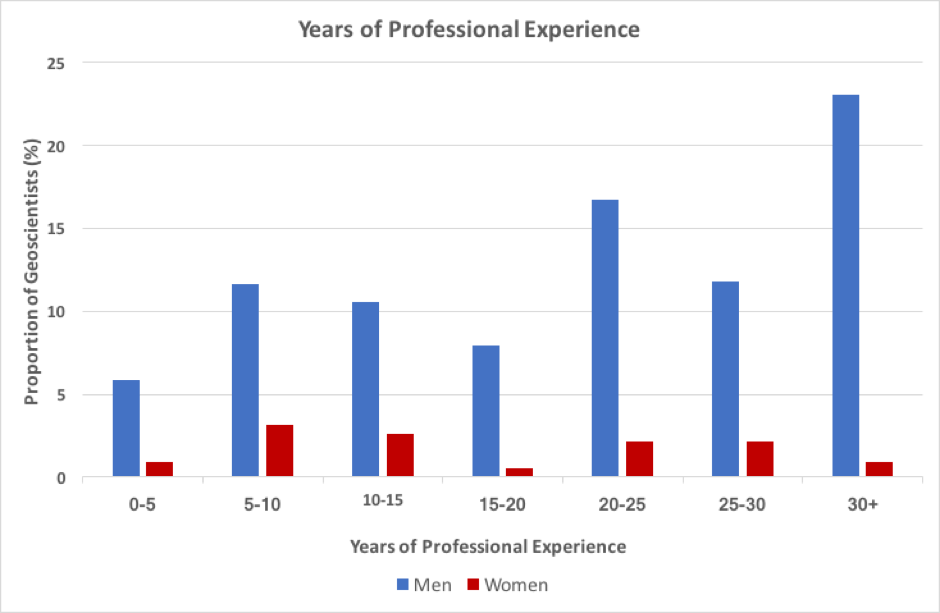
Figure 4. Current gender diversity by years of professional experience.
The same data, grouped by gender, possibly paints a more interesting picture (Figure 5). Amongst young professionals with 0 – 5 years experience, the proportion of men and women, as a percentage of the gender group, is very similar. The proportion of women with 5 – 15 years experience is much higher than for men, while it is lower for between 15 – 20 years experience, and again similar for geoscientists with between 20 – 30 years experience.
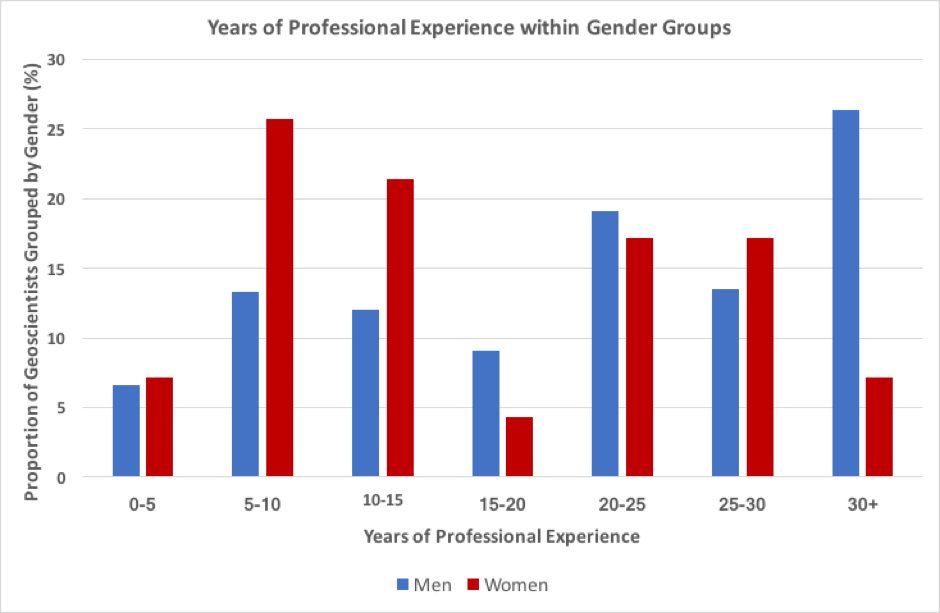
Figure 5. Proportion of geoscientists within gender groups vs years of professional experience.
The data presented in Figure 4 and Figure 5 can be interpreted to reflect the cyclical nature of geoscience employment opportunities. Employment conditions in exploration and mining over the past five years have, without doubt, prevented new talent from taking on geoscience careers. The same factors are considered likely to be responsible for the low numbers of geoscientists with between 15-20 years experience. Women leaving work to support young families is frequently raised as an issue hampering greater diversity in the workforce generally but it’s difficult to see any evidence to support this proposal in these results, especially considering the data for geoscientists with between 5-15 years experience.
Basis and fields of employment also warrant examination in considering this issue. Figure 6 shows that there are only minor differences in the proportion of women and men in full-time, part-time and self-employment. The main difference is evident in part-time employment but this doesn’t comprise a great number of roles. The figures may, however, suggest that part time employment could be being used a means of accessing more flexible working arrangements by a very limited number of geoscientists.
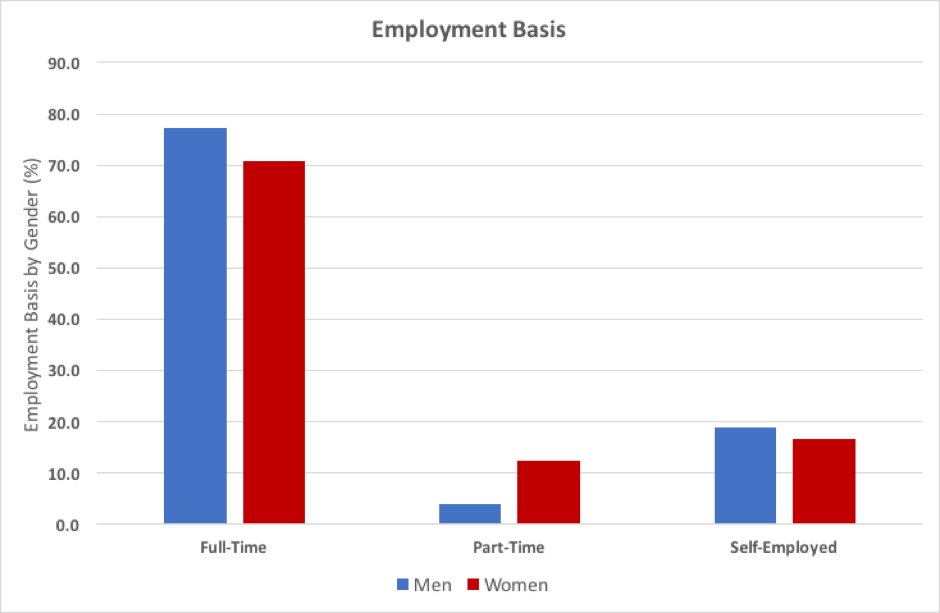
Figure 6. Employment Basis by Gender.
The selection of different professional sectors by men and women presented in Figure 7 shows that the proportion of women geoscientists working in mineral exploration is much lower than for men, but the opposite is evident in energy resource exploration (coal, oil and natural gas), as it is in government and teaching and research. This may reflect an ability to access more flexible working arrangements, and perhaps more rapid adoption of inclusion and diversity principles by organizations in these sectors.
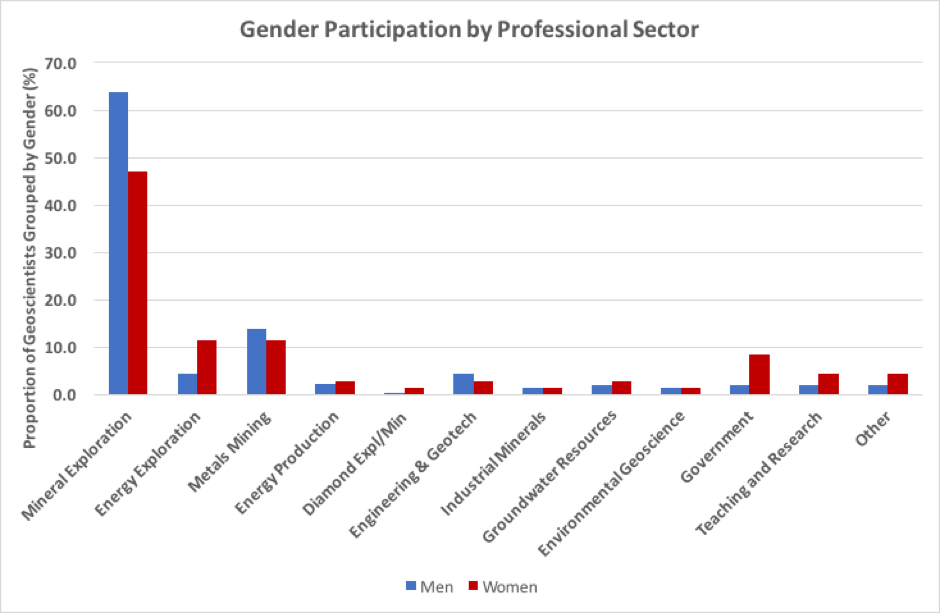
Figure 7. Proportion of men and women working in different professional sectors.
Finally, Figure 8 examines employment of women and men by the different types of enterprise examined by each AIG employment survey. There are some profound differences evident in the data presented. The proportion of women working for large enterprises (major exploration and mining companies) is much lower than the proportion of men. Women in the geoscience workforce are more engaged in geoscience employment by mid-tier exploration and mining companies, and medium to large consulting and contracting firms. The junior exploration and mining sector fares better than their major counterparts, but lag their mid-tier competitors. Small consulting and contracting firms also lag their larger counterparts. The reasons for this could be many and varied. In the case of large vs mid-tier vs junior exploration and mining companies, factors such as commercial agility, human resources policies and attitudes to workplace flexibility may be a good place to start looking for differences that have contributed to the differences evident in the data. Exploration and mining companies may also be more asset and project than people-focussed, perhaps by having access to a broader skills base within their workforces. Consulting and contracting companies are, conversely, essentially people-based businesses whose success very much depends on their ability to deliver results and attract repeat business, which requires investment in people, retention of key staff and building capability, all of which are non-monetary but tanglibe forms of reward for employees.
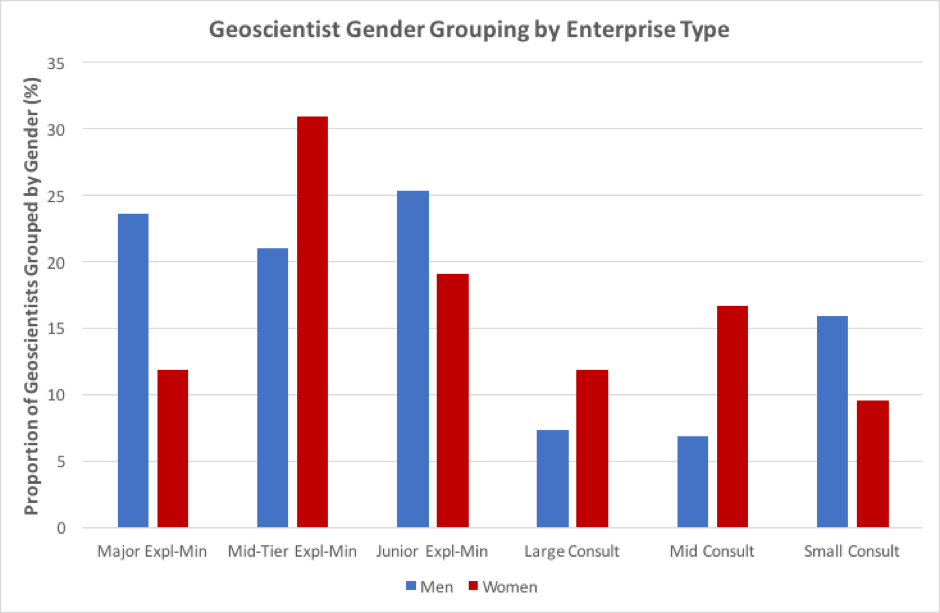
Figure 8. Proportion of men and women employed by different types of enterprise.
There is an interesting discussion to be had around this point. If promotion of inclusion and diversity in workplaces essential to business success there are clearly enterprises employing geoscientists in Australia starting well behind their competitors.
There are clearly issues around the value and benefits of pursuing greater inclusion and diversity in Australian geoscience. These include, but are not limited to:
This discussion was largely confined to gender, which is but one aspect of the overall inclusion and diversity discussion that our profession needs to have. Organisations starting to consider and discuss diversity and inclusion as an issue tend, however, to start with gender as it’s the issue on which most information is typically available. What the right level of gender diversity is for an organisation is frequently where the discussion starts. Obviously, this needs to reflect the community from which the organisation draws requisite qualifications and experience. 50:50 is, arguably, rarely the most appropriate answer. Organisations need to understand the communities they draw upon and structure their approach to the issue in an informed way, bearing in mind that this is something that will not be static. Organisations of all shapes and sizes need to monitor developments and have an agile approach to the issue.
Clearly, the composition of new talent selecting geoscience as the basis of their career is changing rapidly and the challenge facing our profession is to truly embrace this change.
Join a discussion of this topic via the AIG Linkedin group or website (www.aig.org.au). Members with experience of diversity and inclusion issues in their career have a real ability and opportunity to help shape thinking and attitudes for the better.
Andrew Waltho
Reproduced from AIG News 129, September 2017, available here.
The latest edition of AIG News, the Australian Institute of Geoscientists member newsletter is now available in full colour and digital format and best of all FREE for all readers!
Now all AIG Members and Non Members can enjoy our FREE AIG Newsletter in digital format, including all previous editions. Please click here to see our archive of AIG News.
Download the latest copy of AIG News 129 below:
![]() For web: AIG News 129: Download as Single Pages PDF
For web: AIG News 129: Download as Single Pages PDF
![]() For web: AIG News 129: Download as Double Page Spread PDF
For web: AIG News 129: Download as Double Page Spread PDF
![]() For print: AIG News 129: Download as Single Pages PDF
For print: AIG News 129: Download as Single Pages PDF
![]() For print: AIG News 129: Download as Double Page Spread PDF
For print: AIG News 129: Download as Double Page Spread PDF
Inside this latest issue…
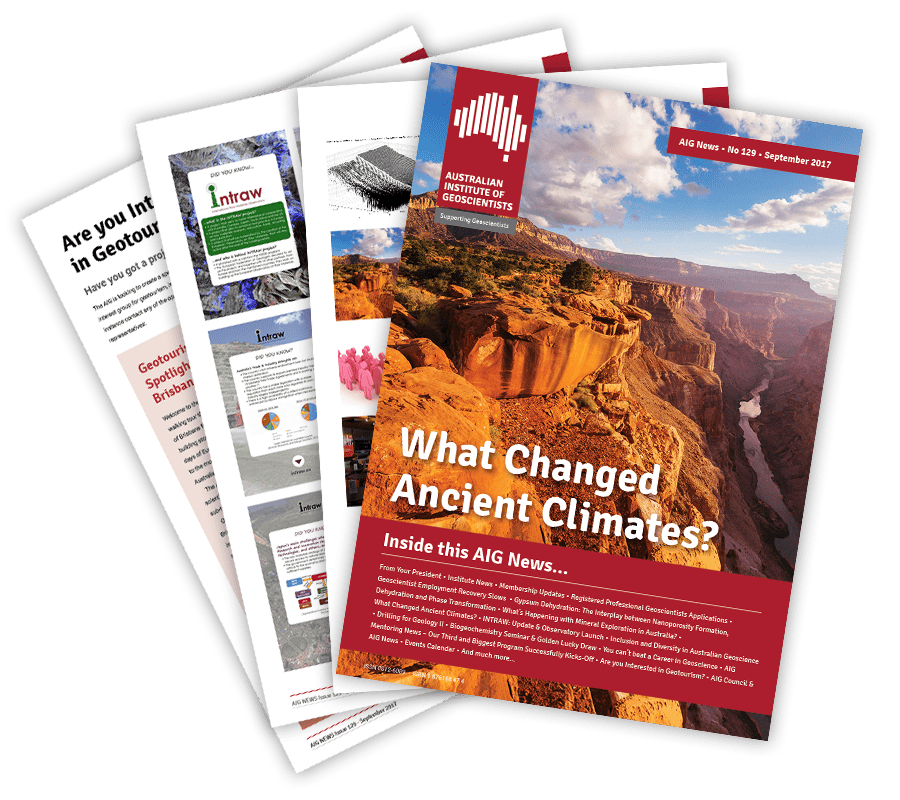 From Your President; Institute News; NSW Branch Report; Education News; Membership Updates & Registered Professional Geoscientists Applications; Geoscientist Employment Recovery Slows; Gypsum Dehydration: The Interplay between Nanoporosity Formation, Dehydration and Phase Transformation; What’s Happening with Mineral Exploration in Australia?; What Changed Ancient Climates?; INTRAW: Update & Observatory Launch; Inclusion and Diversity in Australian Geoscience; Drilling for Geology II; Biogeochemistry Seminar & Golden Lucky Draw; You can’t beat a Career in Geoscience; AIG Mentoring News – Our Third and Biggest Program Successfully Kicks-Off; Are you Interested in Geotourism?; Events Calendar; AIG Council & AIG News and much more…
From Your President; Institute News; NSW Branch Report; Education News; Membership Updates & Registered Professional Geoscientists Applications; Geoscientist Employment Recovery Slows; Gypsum Dehydration: The Interplay between Nanoporosity Formation, Dehydration and Phase Transformation; What’s Happening with Mineral Exploration in Australia?; What Changed Ancient Climates?; INTRAW: Update & Observatory Launch; Inclusion and Diversity in Australian Geoscience; Drilling for Geology II; Biogeochemistry Seminar & Golden Lucky Draw; You can’t beat a Career in Geoscience; AIG Mentoring News – Our Third and Biggest Program Successfully Kicks-Off; Are you Interested in Geotourism?; Events Calendar; AIG Council & AIG News and much more…
AIG News is optimised to be read with Adobe Reader. Versions are available for printing (with Adobe Reader version 4.1.3 or later) or either reading on-line or downloading for reading off-line with your laptop or tablet (with Adobe Reader version 6.1.5 or later). Both versions have been tested and are compatible with Apple Preview and iBooks for Mac and iPad users.
If you experience any difficulty accessing and reading AIG News using the Adobe Reader versions listed here technical support is available.
We hope that you enjoy the latest AIG News and welcome your feedback.
Kaylene Camuti
Member, INTRAW Panel of Experts
The INTRAW project was launched in early 2015 with the objective of mapping best practices in raw materials technology, regulation, research and education. The project also aims to foster cooperation opportunities with technologically advanced non-EU countries. The three-year EU-funded project is part of the European Commission’s Horizon 2020 Programme for Research & Innovation. The project is coordinated by the European Federation of Geologists (EFG), and brings together an international consortium of 15 partners with extensive experience in research, innovation, education, industry, trade and international networking across the entire raw materials value chain.
The ultimate goal of the project is the development of the European Union’s International Observatory for Raw Materials. As a permanent international body, the Observatory will aim to establish and maintain strong long-term relationships with the world’s key players in raw materials technology and scientific developments. Its core activities will be to continuously monitor opportunities for collaboration and cooperation, and to promote these opportunities through funding programs and incentives between the EU and other technologically advanced countries.
The INTRAW project is now in its third year and the launch of the Observatory is scheduled for early November. The Observatory launch represents the culmination of several phases of data acquisition, review, analysis and synthesis, aided by regular intensive workshops with partner organisations and expert panels.
In the first year the project partners reviewed the contextual environment of the raw materials economies in the five reference countries – Australia, Canada, Japan, South Africa, USA – for comparison to the contextual environment of the European Union. The reports on each of the reference countries are available from the INTRAW web site.
In the second year the project partners produced reports analysing the operation of critical processes in the raw materials chain. The three reports covered: Education and Outreach, Research and Innovation, and Trade and Industry. The analyses led to an improved understanding of the factors that have both enhanced and hindered growth and success in the fields of raw materials research & innovation, educational and skills programmes, trade, exploration, exploitation, processing, recycling and substitution. These analytical reports are also available from the INTRAW web site.
When the International Raw Materials Observatory is launched later this year, it will operate as an independent, apolitical, international not-for profit organisation, offering a range of services aimed at promoting international cooperation, including:
The launch of the INTRAW Observatory in November will take place at the EU-Advanced Mining Countries Conference, which is being run as part of the European Commission’s Raw Materials Week in Brussels. Raw Materials Week is an opportunity for the European and international raw materials communities to discuss and exchange information and ideas about issues relevant to raw materials, from discovery to production to recycling, including policy, research, technology, international cooperation, and regulatory issues.
More information to follow soon via http://intraw.eu and @intrawproject.
In the meantime, enjoy the teaser of the INTRAW project video.
Copyright © 2017 INTRAW PROJECT, All rights reserved
PRESS RELEASE | BRUSSELS | APRIL 2017 – The INTRAW project consortium recently launched three operational reports providing insights on best practices and weaknesses of raw materials research & innovation, education & outreach and industry & trade in the five Reference Countries: Australia, Canada, Japan, South Africa and the United States of America.
The EU-funded INTRAW project was launched in 2015 with the aim of mapping best practices and boosting cooperation opportunities related to raw materials between the EU and five technologically advanced non-EU countries (Australia, Canada, Japan, South Africa and the United States). The project consortium now presents three reports that focus on raw materials research & innovation, education & outreach or industry & trade, in the five Reference Countries. These three reports underpin the development of a better understanding of the achievements made in these five countries in relation to the entire raw materials value chain. The operational report on research & innovation describes and compares the different innovation systems in Australia, Canada, Japan, South Africa and the United States, comprising – among others – the main role players, institutions and policies that drive research and innovation in the raw materials sector. The raw materials educational context in each of the Reference Countries is mapped in the operational analysis of education & outreach. The report on industry & trade notably includes the characterisation of industrial clusters related to raw materials in these countries and the way these clusters affect trade and global competition.
The findings of these operational reports also contribute to the design of the International Observatory on Raw Materials that is to be launched by the end of 2017. The Observatory will be a permanent international body that will remain operational after the end of the project, aiming at the establishment and maintenance of strong long-term relationships with the world’s key players in raw materials technology and scientific developments.
The operational reports and their summaries are available through the project website at http://intraw.eu/publications/. As a next step, INTRAW will launch, in the coming weeks, three scenarios describing the world of raw materials in 2050.
INTRAW is funded under the European Commission’s Horizon 2020 EU Research and Innovation Programme, for a period of 36 months (February 2015 – January 2018). Under the coordination of the European Federation of Geologists (EFG), INTRAW brings together an international consortium of 15 partners with extensive experience in research, innovation, education, industry, trade and international networking across the entire raw materials value chain.
MORE INFORMATION: http://intraw.eu
CONTACT:
Coordinator – European Federation of Geologists (EFG)
Vítor Correia, President (efg.president@eurogeologists.eu)
Isabel Fernández Fuentes, Executive Director (isabel.fernandez@eurogeologists.eu)
This project has received funding from the European Union’s Horizon 2020 research and innovation programme under grant agreement n° 642130.

The Tenth International Mining Geology Conference is only two weeks away.
The conference is being presented jointly by AusIMM and AIG in Hobart from 20-22 September.
The conference includes a number of pre-and post-conference excursions and workshops, details of which are available from the conference web site.
With just two months to go, please consider registering now. AIG members have access to a dedicated registration link (hosted by AusIMM).
Keynote Speakers
